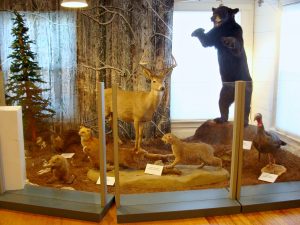The Rockfish Valley Foundation is proud to announce the opening of the Biodiversity Exhibit at the Natural History Center on April 5th. Come and join us to start exploring today!
RVF Guide to Biodiversity: Answers to Some Common Questions
What is biodiversity?
Biological diversity, also known as biodiversity, simply describes the broad variation among living things on Earth. It includes Genetic Diversity (the diversity of genetic materials within species), Species Diversity (the variety of species in all taxonomic groups), and Ecosystem Diversity (the array of communities, ecosystems, and landscapes within which species evolve and coexist). Biodiversity is the result of 3.5 billion years of evolution.
Why is biodiversity important?
Biodiversity and its ecological processes sustain our lives and the lives of other species with which we share the planet – plants produce the oxygen in the atmosphere; microorganisms decompose waste products and recycle nutrients; wetlands filter pollutants and cleanse our waters; insects, birds, and bats pollinate our crops.
Biodiversity provides the raw materials we need – for making food, medicine, fuel, clothing, buildings, and other resources.
Biodiversity is inspirational – and it’s what makes our planet unique. Imagine the planet without the high mountain forests and low valley meadows. Imagine a place where all of our favorite animals are gone. Imagine Earth without any life. We rely on heavily biodiversity for enjoyment through recreation, spiritual fulfillment, and understanding our cultural heritage.
How do scientists measure biodiversity?
Scientists have traditionally measured the biodiversity of an area through species richness (how many species live there) and species evenness (how the species are distributed). The scientific fields through which these concepts are applied are: Ecology (the study of the interactions between current species and their environment), Paleontology (the study of prehistoric life and their environments through fossils), and Systematics (the study of the relationships between past and present species).
How many species exist in the world?
A species is usually defined as a group of organisms that are capable of interbreeding and producing fertile offspring. Approximately 99.9% of all species that once lived on Earth are now extinct. Since we haven’t discovered every creature in the world we don’t know the exact number of current species on the planet, but we have some good estimates based on mathematical models:
- Ocean: ~200 thousand species known vs. ~2.2 million species predicted
- Land: ~1.3 million species known vs. ~8.8 million species predicted
- Total: ~1.5 million species known vs. ~11 million species predicted
Where is biodiversity the greatest?
Since the majority of life thrives in warm and wet environments, biodiversity is greatest around the equator. Specifically, biodiversity of land species is greatest in tropical forests and marine diversity is greatest along coral reefs. Therefore, biodiversity is low around the poles of Earth, places that are cold and dry. Locations with high levels of threatened endemic species (creatures that only exist in that spot and nowhere else on the entire planet) are called biodiversity hotspots.
What are the major threats to biodiversity?
Biodiversity losses can be attributed to the resource demands of our rapidly growing human population. In modern times, the human population has increased from about 1 billion in 1900 to over 7 billion today. Like other living beings, we use natural resources to survive, but we are far more resourceful and destructive to other life-forms than any species previously known. As the world’s human population increases, all the creatures on Earth (including ourselves) must share the same limited resources like food, water, and space. Yet there is less and less natural habitat remaining as land is developed for human habitation and activities. Scientists estimate that half of earth’s biological diversity will be lost by 2100.
The top five threats to biodiversity are:
- Habitat Destruction
- Non-native Invasive Species
- Pollution
- Overuse/Exploitation of Natural Resources
- Global Environmental Change
What are humans doing to help protect biodiversity?
There are differing views when it comes to protecting living things and the environments they inhabit. Some people believe that humans should do nothing about loss of biodiversity. Some people believe in preservation, the setting aside of habitat and other natural resources that cannot be used by humans. Others believe we should find middle ground between the two extremes in the form of resources being managed and used responsibly by humans. This philosophy is called conservation.
Conservation efforts led by Virginia and Federal government agencies, private non-profit organizations, communities, and volunteers are making a difference. These successful improvement efforts include: Virginia Land Conservation Foundation efforts have helped to protect over 7.14 million acres – about 28 percent of Virginia’s land. When land is set aside and development on that land is prohibited, the habitats and species living there are protected as well. So, as we conserve more land, we contribute to the survival of Virginia’s habitats and species.
 What can I do to help protect biodiversity?
What can I do to help protect biodiversity?
One person trying to change the world by themselves will not make a significant impact on the entire planet, but many people standing together for a united cause can make amazing things happen.
- Join an effective rainforest or coral reef conservation organization.
- Be a smart consumer and live sustainably. Practice the 3 Rs – Reduce, Reuse, Recycle. Find out where the products you buy came from and what environmental policies the businesses practice.
- Educate others. Give a presentation. Teach a class. Share your favorite conservation causes on Facebook. Subscribe to conservation YouTube channels.
- Act locally. Join a local stewardship group such as a local chapter of the Virginia Master Naturalist Program, Virginia Master Gardeners, or a local Virginia watershed program.
- Support educational programs and exhibits, like this one, that inform the public.
*The Natural History Center is open on Saturdays and Sundays from 10 a.m. – 4 p.m., April 5th – December 31st.


